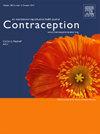OXYTOCIN RECEPTION EXPRESSION IN PREGNANCY: “IS IT TIME TO ADD THE PIT?”
IF 2.3
2区 医学
Q1 OBSTETRICS & GYNECOLOGY
引用次数: 0
Abstract
Objectives
We aimed to measure oxytocin receptor (OXTR) expression changes in the myometrium throughout pregnancy to inform clinical management of post-abortion hemorrhage.
Methods
We obtained myometrial tissue through transcervical core needle biopsies under ultrasound guidance in anesthetized participants immediately following procedural abortion. We also obtained tissue from non-pregnant and term control participants. We compared relative OXTR expression throughout pregnancy using quantitative PCR (qPCR) to evaluate gene expression and immunohistochemistry to assess OXTR protein in samples.
Results
We collected myometrial samples from 29 participants including n=22 following abortion at 6-26 weeks, n=3 undergoing cesarean delivery at term prior to labor, and n=4 undergoing laparoscopic permanent contraception (non-pregnant). Using qPCR, we observed an increase in relative OXTR expression with increasing gestational age. Compared to non-pregnant levels, the relative expression ranges increased from 2.5-fold (SD 3.9) in the first trimester to 96-fold (SD 10.3) at term. To further investigate the changes in expression in the second trimester, we compared mRNA expression in early-, mid-, and late-second trimester subgroups. Compared to the first trimester (<14 week), relative expression increased by 5.8-fold at 14-17 weeks, 16.2-fold at 18-20 weeks, 22.4-fold at 20-26 weeks, and 38.4-fold at term (>37 weeks). Immunohistochemical staining confirmed gestational week dependent increases in OXTR protein levels in the cytosol of myometrial cells.
Conclusions
This study defines changes in OXTR expression throughout pregnancy and provides evidence for an increase in the second trimester. This supports the use of oxytocin in second trimester hemorrhage management, with a notable increase in expression by 18 weeks.
妊娠期催产素接收表达:"是时候加坑了吗?
目的我们旨在测量整个妊娠期子宫肌层中催产素受体(OXTR)表达的变化,为人工流产后大出血的临床治疗提供参考。方法我们在超声引导下,通过经宫颈核心针活检获取子宫肌层组织,受检者在手术流产后立即进行麻醉。我们还从未孕和足月的对照组参与者身上获取了组织。我们使用定量 PCR(qPCR)评估基因表达,并使用免疫组织化学方法评估样本中的 OXTR 蛋白,从而比较了整个妊娠期间 OXTR 的相对表达。通过 qPCR,我们观察到随着妊娠年龄的增加,OXTR 的相对表达量也在增加。与未孕水平相比,相对表达范围从头三个月的 2.5 倍(标准差 3.9)增加到足月时的 96 倍(标准差 10.3)。为了进一步研究妊娠后三个月的表达变化,我们比较了妊娠后三个月早期、中期和晚期亚组的 mRNA 表达。与妊娠头三个月(14 周)相比,相对表达量在 14-17 周增加了 5.8 倍,18-20 周增加了 16.2 倍,20-26 周增加了 22.4 倍,足月时(37 周)增加了 38.4 倍。免疫组化染色证实,子宫肌细胞胞浆中 OXTR 蛋白水平的增加与孕周有关。这支持了催产素在妊娠后三个月出血处理中的应用,其表达在 18 周时显著增加。
本文章由计算机程序翻译,如有差异,请以英文原文为准。
求助全文
约1分钟内获得全文
求助全文
来源期刊

Contraception
医学-妇产科学
CiteScore
4.70
自引率
17.20%
发文量
211
审稿时长
69 days
期刊介绍:
Contraception has an open access mirror journal Contraception: X, sharing the same aims and scope, editorial team, submission system and rigorous peer review.
The journal Contraception wishes to advance reproductive health through the rapid publication of the best and most interesting new scholarship regarding contraception and related fields such as abortion. The journal welcomes manuscripts from investigators working in the laboratory, clinical and social sciences, as well as public health and health professions education.
 求助内容:
求助内容: 应助结果提醒方式:
应助结果提醒方式:


